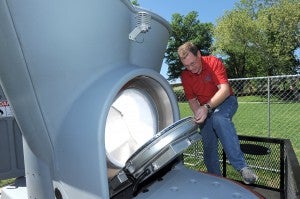Monday, Dec. 2, 2013
[social_share/]HUNTINGTON, W.Va. – Officials at the West Virginia Brownfields Assistance Center at Marshall University today announced an expansion of their partnership with the West Virginia Division of Energy’s Office of Coalfield Community Development to explore the reuse and redevelopment potential of land that has been surface-mined.

Over the past several years, the two organizations have worked together to demonstrate and evaluate renewable energy applications on former surface-mined properties. Projects have included assessments of wind, solar and biomass energy, as well as hydropower.
Today’s announcement includes two initiatives that will further those efforts and adds a new project to study redevelopment opportunities.
According to center director George Carico, the Division of Energy and the Appalachian Regional Commission are providing $355,000 in funding for the three new projects, which will be completed over the next two years.
“Our efforts in recent years with the West Virginia Division of Energy have produced multiple renewable energy demonstration and research projects, and we’ve gained valuable knowledge about a number of surface-mined lands available for redevelopment,” said Carico. “We continue to play a primary role in reuse and redevelopment of West Virginia’s surface mine lands for progressive and innovative new purposes, and welcome the opportunity to expand our efforts in bringing new life to these properties after mining activities have been completed.”
Carico said that for the first project they will use state-of-the-art Sonic Detection and Ranging (SODAR) equipment to continue wind measurement studies designed to help identify promising wind energy sites. Carico said six sites were evaluated in a previous phase and this new funding will allow them to add three or four additional sites to the study.
Through the second initiative, the Brownfields Assistance Center will administer a grant program to support renewable energy projects on surface-mined land. Competitive grants of up to $40,000 each will be awarded to projects with the potential to yield renewable energy from biomass, wind or solar sources. Examples of fundable projects include demonstration plantings of biomass energy crops like switchgrass, a small wind or solar system for classroom instructional purposes, and solar- or wind-powered generation as a backup energy source for an industrial park built on a reclaimed mine site. Each grant will require a 50 percent match and will have a 12-month timeframe for completion. The Appalachian Regional Commission will make the final determination on project funding. A Request for Proposals is available at www.wvbrownfields.org.
The third project announced today will involve a study of various options for redeveloping surface mine sites to meet local or regional economic development needs. The options to be evaluated include commercial or industrial applications, specialty housing, and agricultural or recreational use.
The West Virginia Brownfields Assistance Center at Marshall University is a program of the university’s Center for Environmental, Geotechnical and Applied Sciences (CEGAS).
For more information, contact Carico at carico@marshall.edu or 304-696-5456.
Contact: Ginny Painter, Communications Director, Marshall University Research Corporation, 304.746.1964